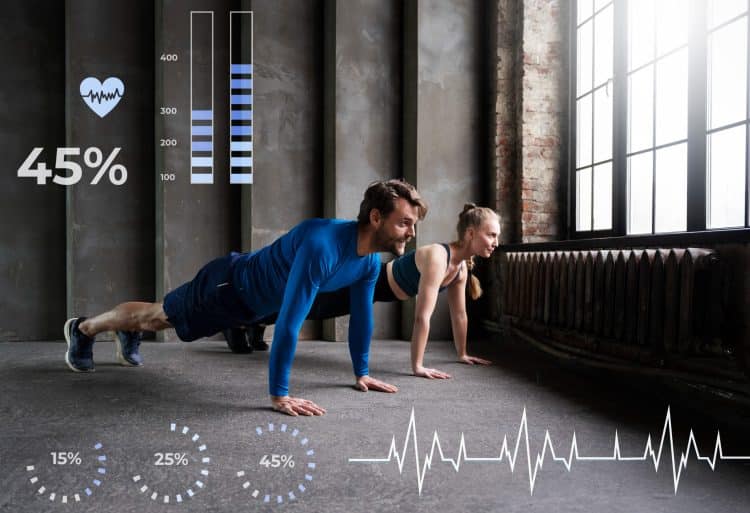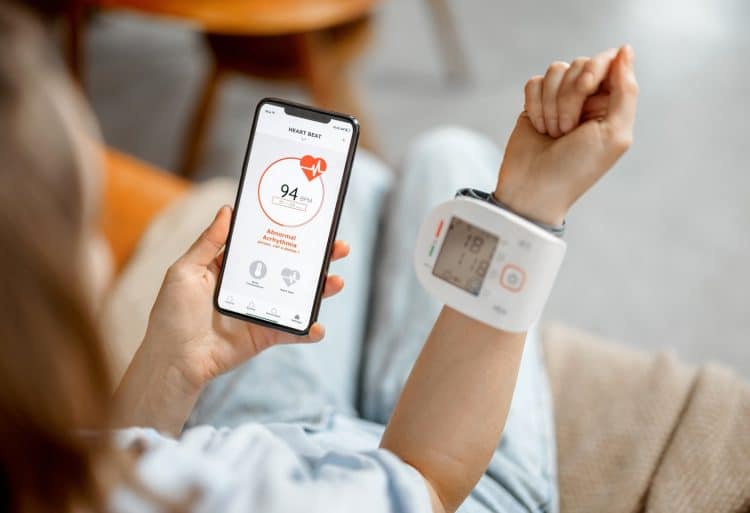The average exercise heart rate varies, typically ranging from 50-85% of your maximum heart rate, often reaching 150-190 bpm for beginners and up to 180-200 bpm during intense physical activity.
Whether you are into bodybuilding, strongman, Olympic weightlifting, or CrossFit, one thing remains consistent — you’ll notice a heart rate spike during intense workouts. As a personal trainer with seven years of hands-on experience, I often use average exercise heart rate to assess my client’s training performance.
A study published in Sports Medicine found that individuals can tailor their training sessions to optimize training intensities for both health and performance benefits by measuring and analyzing average heart rates during exercise. This approach is particularly beneficial for athletes and individuals undergoing rehabilitation. (1)
In this article, we delve into the ideal average exercise heart rate for people across ages, how to calculate average exercise heart rate and factors that can influence your heart rate.
Average Exercise Heart Rate — Primer
Your heart rate is the number of times your heart beats per minute (BPM). Healthcare experts use this vital health metric to understand an individual’s cardiovascular system’s efficiency and response to physical activities.
Level Up Your Fitness: Join our 💪 strong community in Fitness Volt Newsletter. Get daily inspiration, expert-backed workouts, nutrition tips, the latest in strength sports, and the support you need to reach your goals. Subscribe for free!
The role of monitoring heart rate during exercise goes beyond safety; it can help optimize your performance. It can help you avoid overtraining and undertraining and significantly boost your training efficiency.
Average exercise heart rate is the mean heart rate maintained over your workout’s duration. Ensuring you are in the right heart rate zone for most of your training sessions can boost fat loss and improve endurance and cardiovascular health.
I cannot tell you how often I see people trying to lose weight training in zone 3 and even zone 4. Although training at a higher average exercise heart rate might feel right, it might not produce the desired results.
Target Average Exercise Heart Rate
According to the American Heart Association, here are the target average exercise heart rate numbers for adults of different ages: (2)
| Age | Target Average Exercise HR Zone 50-85% | Average Maximum Heart Rate, 100% |
| 20 years | 100-170 bpm | 200 bpm |
| 30 years | 95-162 bpm | 190 bpm |
| 35 years | 93-157 bpm | 185 bpm |
| 40 years | 90-153 bpm | 180 bpm |
| 45 years | 88-149 bpm | 175 bpm |
| 50 years | 85-145 bpm | 170 bpm |
| 55 years | 83-140 bpm | 165 bpm |
| 60 years | 80-136 bpm | 160 bpm |
| 65 years | 78-132 bpm | 155 bpm |
| 70 years | 75-128 bpm | 150 bpm |
Ideal Average Heart Rate Zones For Different Goals
Now that you know the overall average exercise heart rates, it is time to go a little deeper and dissect these numbers according to varying training objectives.
Here are the target heart rate zones for burning fat, boosting endurance, and achieving peak physical performance:
Fat Burning
To optimally burn fat, you must be at 50-70% of your maximum heart rate (MHR). This will mostly keep you in zone 2. Since zone 2 workouts are not as intense, you can perform them for extended periods. This is the reason LISS (low-intensity steady-state) cardio is such a hit among weight loss enthusiasts.
Building Endurance
Training for endurance requires you to operate at 70-85% of your MHR. Plus, you must sustain this effort for extended periods to enhance your cardiovascular capacity, stamina, and endurance.
I never recommend my newbie personal training clients to hop onto an endurance program right off the bat. You must spend some time working on your overall fitness level before you can train for endurance while limiting the risk of overtraining and injury.
Peak Performance
This zone is reserved for short, high-intensity bursts of training, as it involves pushing the heart rate above 85% of MHR. High-intensity interval training (HIIT) is one of the best ways to train for speed and power. However, you cannot sustain these efforts for extended periods.
Make the most out of this form of training by going full-send in each session. However, as I keep repeating to my clients, you cannot compromise training form in favor of intensity and speed. Doing so significantly increases injury risk and is a big no-no.
Calculating Your Average Exercise Heart Rate
Here’s how you can accurately gauge your average exercise heart rate by employing modern and traditional methods:
Warm-Up
Begin with a 5-10 minute warm-up to loosen up and get the blood flowing to the target muscles. This will ensure your heart rate rises gradually, offering a more accurate average reading during exercise.
Use Wearable Tech
Technology has improved by leaps and bounds in every aspect, and it is no different when it comes to measuring your heart rate.
Most smartwatches do a decent job of measuring your heart rate during exercise. However, if you are a professional athlete, I recommend that you use a chest strap heart rate monitor if you want the most reliable results.
These wearable gadgets sync to your smartphone and can provide real-time data. They also record this data, which can help you analyze your training trends over a longer period.
Your average and recovery heart rates can also help develop a personalized recovery program, which can help you recover faster between training sessions.
Tracking your heart rate should not be a one-time thing. I highly recommend that you get into the habit of checking your heart rate multiple times throughout the workout.
Some of my clients have gotten so good at this that they can guess their current heart rate on the fly just by how they feel. It’s all about muscle memory.
This makes adjusting your workouts on the fly much easier and prevents the risk of overtraining. Since you won’t be pushing yourself more than needed, it also significantly limits injury risk.
Traditional Methods
Although the market is flooded with heart rate sensors, you can still assess your average exercise heart rate manually. Do this by placing your index and middle fingers on your neck or wrist.
Count the beats for 15 seconds post-exercise and multiply the number by four to get your average exercise heart rate per minute. For example, if your pulse rate is 30, your average exercise heart rate will be 120 bpm.
Familiarize Yourself with the Zones
Learning about the heart rate zones can pay dividends in the long run. Here are the five training zones:
- Zone 1: 55–65% of MHR
- Zone 2: 65–75% of MHR
- Zone 3: 80–85% of MHR
- Zone 4: 85–88% of MHR
- Zone 5: 90% and above
Understanding the training zones can help you adjust your training intensity according to your objectives.
Check out the Target Heart Rate Calculator
Switching Up Average Exercise Heart Rate
Contrary to what most people think, you don’t need to marry a specific training zone. Keep your workouts interesting and challenging by constantly switching up your training intensity. This form of versatile training can also help avoid plateaus.
Level Up Your Fitness: Join our 💪 strong community in Fitness Volt Newsletter. Get daily inspiration, expert-backed workouts, nutrition tips, the latest in strength sports, and the support you need to reach your goals. Subscribe for free!
This is how I help my clients spice up their training sessions:
- Monitor Heart Rate: Most smartwatches have a built-in heart rate sensor. Consider investing in one if you have the means. It can significantly boost your training performance.
- Begin with a Warm-Up: Irrespective of your training objective, you must begin each session with exercises that elevate your heart rate to the lower end of the fat burning zone. Spend 5-10 minutes before a training session performing dynamic stretches. (3)
- Plan Your Workouts: For my clients’ training for overall fitness and well-being, I program specific days in the weeks to focus on different zones. As an example, Mondays and Thursdays are allocated to endurance training, whereas Wednesdays and Saturdays are marked for intensity sessions for peak performance.
That said, while average exercise heart rate numbers are incredibly useful, you must learn to listen to your body. If you feel overly sore or exhausted from a training session, feel free to perform a low-intensity workout or skip a training session altogether.
Impact of Lifestyle Factors on Exercise Heart Rate
Our heart reacts dynamically to our daily habits, which can also impact the average exercise heart rate. Here are the factors that you must consider:
Sleep
Getting ample sleep is one of the biggest life hacks. A well-rested body is more stable, and the heart functions a lot more efficiently. On the flip side, a lack of sleep or poor sleep quality can elevate your resting heart rate, which can make your heart work harder during training.
You must sleep at least 7-8 hours each night to ensure you give your body, including your heart, enough time to rest and recuperate.
Nutrition
The food you eat is the fuel your body runs on. Give your body highly processed refined foods to process, and your heart will have a hard time pumping blood through the clogged arteries, leading to a high resting heart rate.
Focus on eating whole foods and meeting your daily macro and micronutrient targets to ensure your heart is in the best shape and working optimally.
Stress
You’ve probably noticed that your heart rate goes through the roof when you are stressed. Training with high blood pressure can be catastrophic. However, regular exercise can help lower cortisol levels, helping reduce overall stress levels.
That said, people with pre-existing medical conditions must get a doctor’s clearance before starting a new training or diet program.
Hydration
Drinking less water can lead to dehydration, which can thicken the blood. Your heart has to work overtime to circulate thicker blood, raising your resting heart rate and an increased heart rate during training.
Ensure adequate hydration before, during, and after a training session. Aim for a gallon of water daily for optimal body functioning and training performance.
Check Out: Heart Rate Based Calorie Burn Calculator
The Physiological Impact of Exercise on Heart Rate
Exercise transforms the heart, both in the moment and over time.
The high heartbeat you notice during a training session ensures your muscles receive adequate oxygen and nutrients to perform optimally.
Here’s how your heart and heart rate respond to exercise:
Immediate Response
As you start working out, your heart rate spikes to accommodate the muscles’ demands for more oxygen and nutrients. However, this increase in the heart rate can vary depending on the exercise intensity, your fitness levels, and environmental factors.
Steady State
After the initial spike during a workout, your heart rate stabilizes, which is what is known as the average exercise heart rate. Your body arrives at this average heart rate when it is able to meet your muscles’ ongoing energy and nutrient demands.
Recovery
You can notice a gradual decline in your heart rate after an intense training session. Notably, the speed of this recovery is a potent indicator of your fitness levels. The quicker your heart rate returns to its resting state, the better conditioned your cardiovascular system is.
The Science of Average Exercise Heart Rate
As a personal trainer, I try to help my clients understand and apply the principles of average exercise heart rate to boost their training performance. Here are the things you should know to supercharge your training approach:
Understanding Heart Rate Variability
Aerobic training, such as jogging or swimming, typically keeps your heart rate in a moderate range, which can boost your endurance and stamina.
Conversely, anaerobic exercises, like sprinting or circuit training, thrust your heart rate higher. This helps you perform in short, intense bursts and boosts your metabolic rate and fat burning.
Role of Heart Rate in Physical Transformation
The average exercise heart rate helps your body determine which energy source to tap into. Moderate-intensity training is ideal for maximizing fat oxidation or the body’s ability to burn fat for energy.
Stay within the three ideal average exercise heart rate ranges mentioned in this article to achieve your training objectives. I have my clients wear a heart rate monitor to ensure they’re on the right path.
Next Read: Average Heart Rate for Athletes (Unlocking Peak Performance)
Real-World Application of Average Exercise Heart Rate
If you are anything like me, you probably understand things better with real-world examples. So, here is a lowdown of how average exercise heart rate works in different training scenarios:
CrossFit
CrossFit training is all about variance. These athletes integrate HIIT and steady-state cardio into their training to achieve peak fitness levels.
A CrossFit WOD might feature AMRAP burpees or a 5K run, and the athletes must be ready for it. The ability of a CrossFitter to maintain an optimal heart rate can boost their training performance.
Bodybuilding
Bodybuilders, often stereotyped as shunning cardio, can use LISS cardio to maintain a lower average exercise heart rate. This allows them to burn fat without sacrificing hard-earned muscle mass.
Working with an experienced professional can help you achieve your training goals. Although it might cost you a little money upfront, it can save you a lot of time, money, and wasted effort.
Conclusion
Monitoring your average exercise heart rate is a quick and easy way to boost your training performance. Wear a heart rate monitor during your workouts for reliable heart rate monitoring and ensure you’re training in the right zone to ensure the best results.
If you have any questions about average exercise heart rate, drop them in the comments below, and I’ll be happy to help!
References
- Karvonen, J., & Vuorimaa, T. (1988). Heart rate and exercise intensity during sports activities. Practical application. Sports medicine (Auckland, N.Z.), 5(5), 303–311. https://doi.org/10.2165/00007256-198805050-00002
- American Heart Association. Target Heart Rates. American Heart Association website. https://www.heart.org/en/healthy-living/fitness/fitness-basics/target-heart-rates. Accessed February 10, 2024.
- Opplert, J., & Babault, N. (2018). Acute Effects of Dynamic Stretching on Muscle Flexibility and Performance: An Analysis of the Current Literature. Sports medicine (Auckland, N.Z.), 48(2), 299–325. https://doi.org/10.1007/s40279-017-0797-9
Article Updates Timeline:
Our editorial team experts constantly update the articles with new information & research, ensuring you always have access to the latest and most reliable information.
February 12, 2024
Written By
Vidur Saini
Edited By
Editorial Team
Fact Checked By
Dr. Malik

















Hi,
heart rate is important. The heart rate and respiratory rate during exercise increase in proportion to the magnitude of the load. It is necessary to dose the cardio-respiratory load by breathing, not by heart rate. WHO’s recommendation on load dosing: medium intensity – we can talk, but we can’t sing, high intensity – we can talk. The heart monitors can be discarded.
Igor. From Moscow with love.